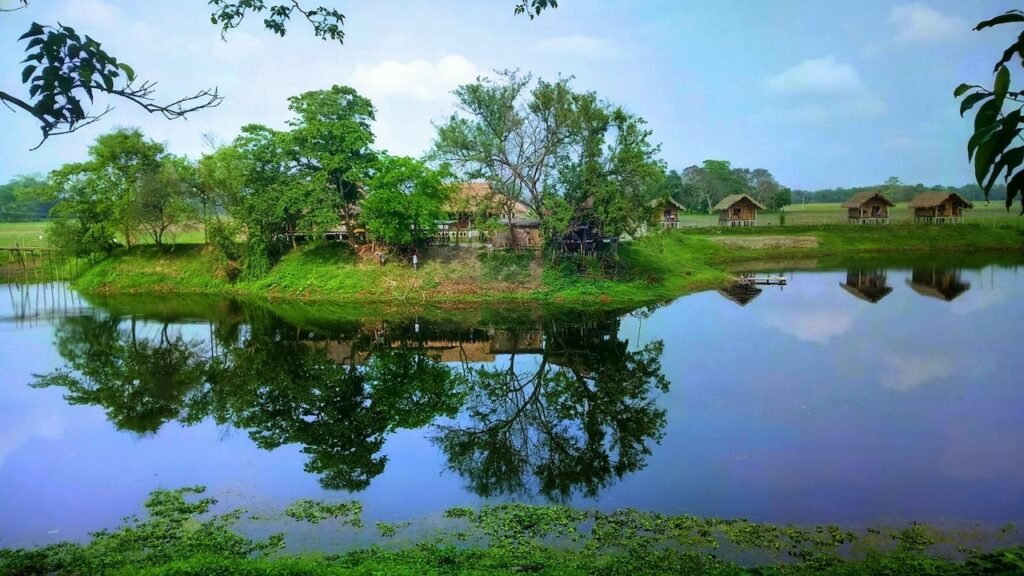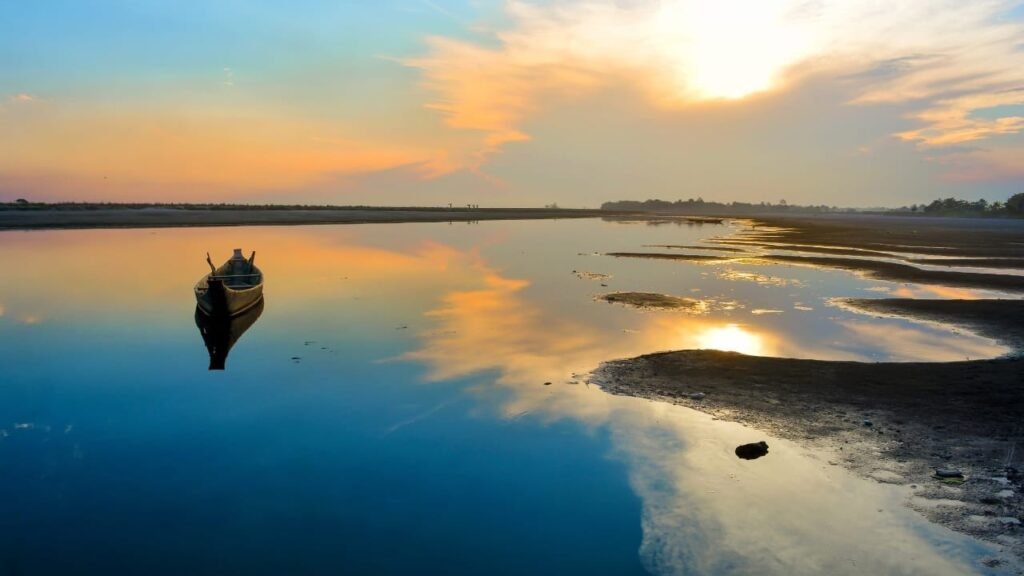Majuli Island, the world’s largest inhabited river island, is a captivating blend of nature, history, and Assamese culture. Located in the heart of Assam, atop the mighty Brahmaputra River, Majuli has established itself as a spiritual, cultural, and ecological treasure trove for India and the globe. Majuli’s serene beauty, unique ethnic tapestry, and rich Vaishnavite heritage draw visitors seeking both solace and adventure.
Majuli Island is not just a geographical wonder; it is a living museum where history, natural beauty, and spiritual traditions coexist. Formed by centuries of riverine process, Majuli’s landscape and people have weathered floods, erosion, and isolation, yet their culture thrives. Today, Majuli stands as the largest midstream delta, symbolising resilience, harmony, and legacy through its centuries-old Vaishnavite satras, vibrant festivals, and welcoming tribal communities.
Location & How to Reach Majuli
Majuli Island is situated on the Brahmaputra River, approximately 80km long and 15km wide at its widest point, in Assam, northeast India. It lies roughly 200 km from Guwahati, Assam’s largest city. Reaching the island involves a journey to Jorhat, a major city in Assam, after which visitors must board a ferry from Nimati Ghat to reach Majuli. There are no direct roadways to the island; all travel is by boat, with regular ferry services available from Jorhat.
- Nearest Airport: Jorhat Airport (Rowriah), 48km away
- By Rail: Jorhat is the nearest railhead; buses/taxis from here to ferry ghats
- By Road: Guwahati to Jorhat by bus (7 hours), then ferry
- Within Majuli: Cycles, walking; no taxis or autos
Historical Significance
Majuli’s story dates back at least to the early 16th century. The Majuli Island gained cultural prominence when Srimanta Sankardev, a revered Assamese saint and social reformer, arrived and spread his neo-Vaishnavite teachings. Sankardev and his disciple, Madhavdev, established satras (Hindu monasteries), transforming Majuli into the spiritual hub of Assam. The island became central to the Bhakti Movement and continues to embody non-violence and devotion through its traditions.
Majuli remained largely isolated, developing its own unique society and practices. Over the centuries, it has played a role in major Assamese historical movements, such as the Moamariya rebellion, the freedom struggle, and contemporary events like the Assam Movement. In September 2016, Majuli was declared a district by the Assam government, underlining its enduring significance.
Cultural Heritage
Majuli is home to the Mising, Deori, and Sonowal Kachari tribes, each of which contributes distinct customs, crafts, and cuisines. The satras are the spiritual and social backbone, where monks practice bhakti, compose art, and perform traditional drama called Bhaona.
Unique Traditions
- Vaishnavite Satras: Over 20 satras, including Auniati, Kamalabari, Garamur, Dakhinpat, and Samaguri Satra.
- Mask-Making: Majuli’s mask dance and mask-making, central to festivals like Raas Leela. Samaguri Satra is famed for its artisans.
- Mising Villages: Tribes practising fishing, weaving, clay pottery, and cultivating unique art forms.
Festivities
Majuli’s festivals, notably Raas Leela and Bhaona, attract thousands annually. These events are marked by music, dance, and masked drama, reflecting the island’s spiritual fervour and storytelling prowess.
Top Tourist Spots in Majuli
Majuli offers a stunning array of tourist attractions, each steeped in history or natural beauty.
Adventurous Activities
Adventure lovers can enjoy boat rides, bicycle tours, riverbank exploration, and bird-watching. The island’s low-lying grasslands and wetlands host over a hundred bird species, making it a haven for naturalists.

Environmental Challenges & Conservation
Majuli’s greatest challenge is erosion. Historically, it covered over 1,300 km², but now shrinks each year due to floods and the Brahmaputra’s power. Assam’s government and local residents combat erosion through embankments, road projects (like the Jorhat-Majuli embankment-cum-road), and traditional practices like planting Kanchan trees along the banks. Floods threaten livelihoods, particularly those of the tribal pottery community, and conservation remains vital for Majuli’s future.
Economy, Revenue & Livelihood
Majuli’s economy is artisan-driven, with locals producing a range of items, including masks, pottery, textiles, and food. Festivals and spiritual tourism generate substantial revenue, while agriculture (especially rice cultivation), fishing, and weaving support daily life. Recent eco-tourism initiatives and government funding are promoting sustainable development, with projects such as solar lighting, water filters, and empowerment schemes in action.
FAQs About Majuli Island
What makes Majuli Island Unique?
Majuli is the world’s largest river island and a centre of Assamese neo-Vaishnavite culture, renowned for its satras, mask-making, and festivals.
How can tourists reach Majuli Island?
Tourists travel to Jorhat, then use ferry services from Nimati Ghat to reach Majuli; the island is not directly connected by road.
What are the top places to visit in Majuli?
Must-see places include Auniati Satra, Garamur Satra, Dakhinpat Satra, Kamalabari Satra, Samaguri Satra, Tengapania, and Mising villages.
What are Majuli Island’s famous festivals?
Raas Leela, Bhaona, and numerous Vaishnavite celebrations in the satras showcase Majuli’s spiritual vibrancy.
What threats does Majuli face?
The primary threat is riverbank erosion and flooding caused by the Brahmaputra, leading to loss of land and heritage.
What is the main livelihood on the island?
Artisan crafts, rice farming, fishing, mask-making, weaving, and tourism are the key sources of income for locals.
Is Majuli recognised internationally?
Majuli is proposed for UNESCO World Heritage status and is celebrated globally for its unique culture and ecology.
Is Majuli safe for tourists?
Majuli is peaceful, welcoming, and safe for visitors. Floods during the monsoon may impact travel, but local hospitality is unwavering.
